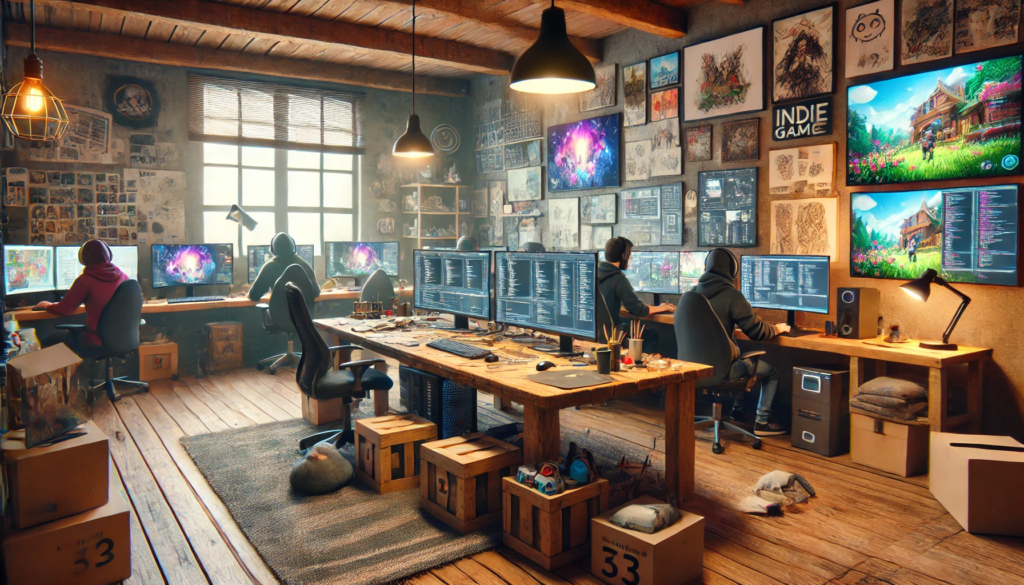
A New Wave in Gaming
The world of video games has been dominated for decades by big-budget AAA titles backed by massive studios. However, in recent years, a new player has emerged to disrupt the landscape: indie games. Created by small, independent developers, these games have risen from niche status to global phenomena, captivating players with their originality, creativity, and heart. But what makes indie games so special, and how are they reshaping the future of gaming?
Defining Indie Games: Small Teams, Big Ideas
Indie games, short for independent games, are developed by small teams or sometimes even a single person without the financial backing or creative restrictions of major publishers. This independence allows developers to take risks and explore ideas that mainstream studios often shy away from. Titles like Hades, Celeste, Hollow Knight, and Among Us have not only become critical and commercial successes, but they’ve also proven that you don’t need a huge budget to make a game that resonates with millions.
What sets indie games apart is their focus on storytelling, gameplay innovation, and artistic expression. These developers often pour their personal experiences, emotions, and vision into their games, creating something that feels intimate and unique. This authenticity is a key reason why players are increasingly drawn to indie titles.
Why Players Love Indie Games: Freedom to Innovate
One of the most compelling aspects of indie games is their freedom from the constraints of large corporations. Indie developers aren’t beholden to shareholders or marketing teams, which means they can experiment with new gameplay mechanics, explore niche genres, and tackle unconventional themes. Whether it’s a deeply personal narrative about mental health or a quirky puzzle game with mechanics never seen before, indie developers have the creative liberty to explore uncharted territory.
Additionally, indie games often offer a personal connection between developers and players. Many indie games reflect the individual vision of their creators, making them feel more genuine and relatable. These games frequently tackle emotional themes such as loss, anxiety, or personal growth in ways that mainstream titles rarely do. This level of emotional depth resonates with players who are looking for meaningful experiences rather than just flashy graphics and action-packed sequences.
Affordability is another key factor in the popularity of indie games. Priced lower than AAA titles, indie games are more accessible to a wider audience. For the price of one big-budget game, players can often experience several high-quality indie titles, each offering a distinct and memorable experience.
How Indie Games Are Shaping the Industry
The influence of indie games extends far beyond their small size. These titles are at the forefront of innovation in the gaming industry, often leading the charge in gameplay mechanics, art styles, and narrative techniques. Major studios have taken notice, with some even adopting ideas first pioneered by indie developers. For example, games like Minecraft and Undertale, which started as indie projects, have sparked trends that continue to shape the gaming landscape.
Indie games have also contributed to increasing diversity in the industry. The independent nature of these projects allows developers from a variety of backgrounds to tell stories that might otherwise be overlooked. This has led to greater representation in games, both in terms of the characters we play and the people creating them. As a result, the gaming community is becoming more inclusive, welcoming voices and experiences that challenge the status quo.
The rise of indie games has also been supported by the growth of digital distribution platforms like Steam, itch.io, and the Nintendo eShop. These platforms have made it easier for indie developers to reach a global audience, bypassing the traditional need for physical distribution. Crowdfunding platforms like Kickstarter have further empowered indie creators, allowing players to support games in development and become part of the creative process.
Challenges on the Indie Path
Despite their many successes, indie developers face significant challenges. Funding remains one of the biggest obstacles, as most indie studios lack the financial resources of major companies. Many developers rely on personal savings, crowdfunding, or small grants to bring their visions to life, which can add immense pressure to succeed.
The crowded marketplace is another challenge. With thousands of games being released each year, standing out in a sea of content can be incredibly difficult for indie developers. Unlike AAA studios that have the luxury of massive marketing campaigns, indie developers must often rely on word of mouth, social media, and community engagement to build an audience.
The Bright Future of Indie Games
Despite these hurdles, the future of indie games is bright. More platforms, like the Nintendo Switch, Xbox Game Pass, and even streaming services, are embracing indie titles, helping them reach wider audiences. The rise of content creators on YouTube and Twitch has also played a crucial role in the success of indie games, with streamers highlighting hidden gems and helping small developers gain visibility.
As technology continues to advance, the tools needed to create high-quality games are becoming more accessible. This means that indie developers will have even more opportunities to push the boundaries of creativity and innovation in gaming. The success of indie titles is also inspiring a new generation of creators who want to share their unique perspectives with the world.
A Force to Be Reckoned With
Indie games have proven to be much more than a passing trend; they are a vital part of the gaming ecosystem, driving innovation, diversity, and creativity. With their intimate storytelling, affordable prices, and bold experimentation, indie games offer players experiences that are often more personal and impactful than their big-budget counterparts.
As the indie scene continues to grow, these games will undoubtedly play an even bigger role in shaping the future of the gaming industry. Whether you’re searching for something emotionally resonant, artistically daring, or simply fun and different, indie games have something to offer every kind of player.


